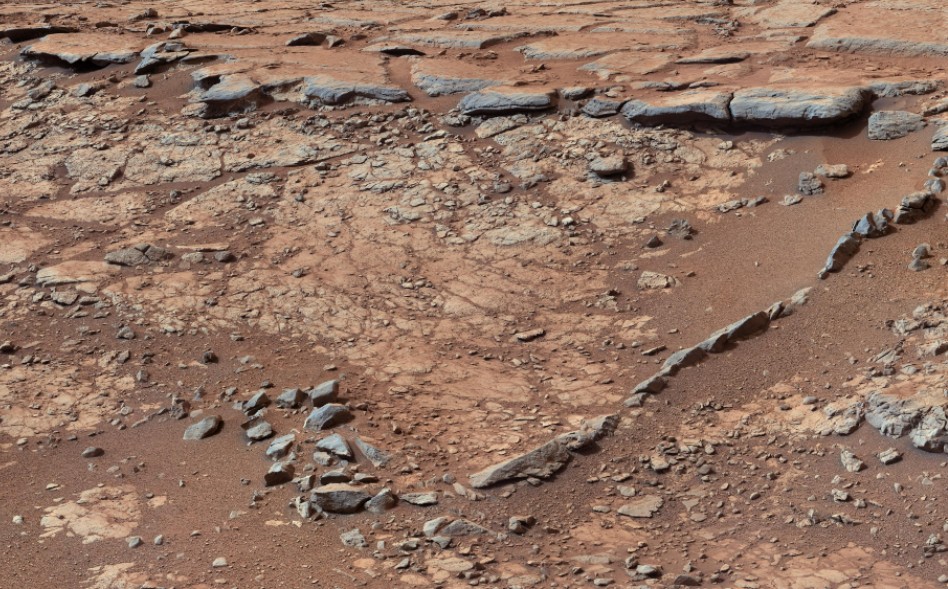
Mars news: Key life matter found, public help sought for cloud-spotting
Organic carbon has been found on Mars before, but prior measurements only produced information on particular compounds; the new measurement gives the total amount of organic carbon in these rocks

For the first time, NASA scientists, using data from the Curiosity Rover, have measured the total organic carbon – a key component in the molecules of life – in Martian rocks.
According to the National Aeronautics and Space Administration (NASA), organic carbon is carbon bound to a hydrogen atom. It is the basis for organic molecules, which are created and used by all known forms of life. However, organic carbon on Mars does not prove the existence of life there because it can also come from non-living sources, such as meteorites and volcanoes, or be formed in place by surface reactions.
Also read: NASA’s Perseverance rover spots a shiny piece of foil on Mars
Organic carbon has been found on Mars before, but prior measurements only produced information on particular compounds, or represented measurements capturing just a portion of the carbon in the rocks. The new measurement gives the total amount of organic carbon in these rocks.
Although the surface of Mars is inhospitable for life now, there is evidence that billions of years ago the climate was more Earth-like, with a thicker atmosphere and liquid water that flowed into rivers and seas. Since liquid water is necessary for life as we understand it, scientists think Martian life, if it ever evolved, could have been sustained by key ingredients such as organic carbon, if present in sufficient amount, NASA said.
Curiosity is advancing the field of astrobiology by investigating Mars’ habitability, studying its climate and geology. The rover drilled samples from 3.5-billion-year-old mudstone rocks in the Yellowknife Bay formation of Gale crater, the site of an ancient lake on Mars.
Mudstone at Gale crater was formed as very fine sediment (from physical and chemical weathering of volcanic rocks) in water settled on the bottom of a lake and was buried. Organic carbon was part of this material and got incorporated into the mudstone.
Measurement process
Besides liquid water and organic carbon, Gale crater had other conditions conducive to life, such as chemical energy sources, low acidity, and other elements essential for biology, such as oxygen, nitrogen, and sulphur.
To make the measurement, Curiosity delivered the sample to its Sample Analysis at Mars (SAM) instrument, where an oven heated the powdered rock to progressively higher temperatures. This experiment used oxygen and heat to convert the organic carbon to carbon dioxide (CO2), the amount of which is measured to get the amount of organic carbon in the rocks.
Also read: This ‘pet’ rock goes wherever Mars rover Perseverance goes
“Total organic carbon is one of several measurements (or indices) that help us understand how much material is available as feedstock for prebiotic chemistry and potentially biology,” Jennifer Stern of NASA’s Goddard Space Flight Center said in a statement.
“We found at least 200 to 273 parts per million of organic carbon. This is comparable to or even more than the amount found in rocks in very low-life places on Earth, such as parts of the Atacama Desert in South America, and more than has been detected in Mars meteorites,” she added.
“Basically, this location (Yellowknife Bay formation of Gale crater) would have offered a habitable environment for life, if it ever was present,” said Stern, lead author of a paper about this research published June 27 in the Proceedings of the National Academy of Sciences.

NASA seeks public help to find clouds on Mars
Meanwhile, NASA scientists are hoping to solve a fundamental mystery about Mars’ atmosphere, and you can help.
They’ve organised a project called Cloudspotting on Mars that invites the public to identify Martian clouds using the citizen science platform Zooniverse. The information may help researchers figure out why the planet’s atmosphere is just 1% as dense as Earth’s even though ample evidence suggests the planet used to have a much thicker atmosphere, NASA said.
Like Earth, Mars has clouds made of water ice. But unlike Earth, it also has clouds made of carbon dioxide (think: dry ice), which form when it gets cold enough for the Martian atmosphere to freeze locally. By understanding where and how these clouds appear, scientists hope to better understand the structure of Mars’ middle atmosphere, which is about 30 to 50 miles (50 to 80 kilometres) in altitude, NASA added.
“We want to learn what triggers the formation of clouds – especially water ice clouds, which could teach us how high water vapor gets in the atmosphere – and during which seasons,” said Marek Slipski, a postdoctoral researcher at NASA’s Jet Propulsion Laboratory in Southern California.
That’s where Cloudspotting on Mars comes in. The project revolves around a 16-year record of data from the agency’s Mars Reconnaissance Orbiter (MRO), which has been studying the Red Planet since 2006, NAS said.

